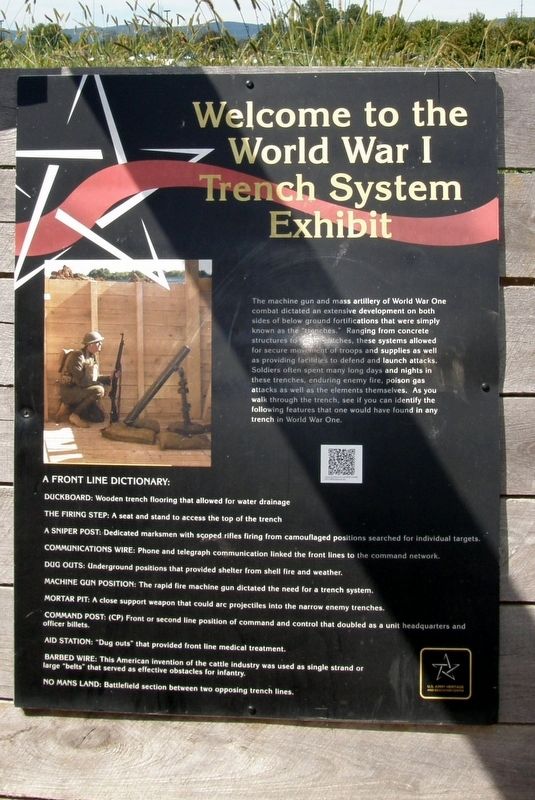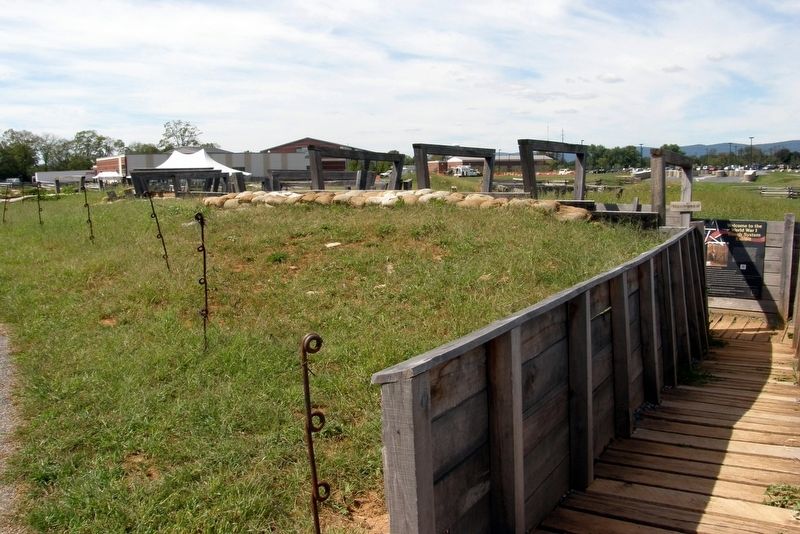Middlesex Township near Carlisle in Cumberland County, Pennsylvania — The American Northeast (Mid-Atlantic)
Welcome to the World War I Trench System Exhibit
Inscription.
The machine gun and mass artillery of World War One combat dictated an extensive development of both side of below ground fortifications that were simply known as the ‘Trenches”. Ranging from concrete structures to simple ditches, these systems allowed for secure movement of troops and supplies as well as providing facilities to defend and launch attacks. Soldier often spent many long days and nights in these trenches, enduring enemy fire, poison gas attacks as well as the elements. As you walk through the trench, see if you can identify the features that one would have found in any trench in World War One.
A Front Line Dictionary:
Duckboard: Wooden trench flooring that allowed for water drainage.
The Firing Step: A seat and stand to access the top of the trench.
A Sniper Post: Dedicated marksmen with scoped rifles firing from camouflaged positions searched for individual targets.
Communications Wire: Phone and telegraph communication linked the front line to the command network.
Dug Outs: Underground positions that provided shelter from shell fire and weather.
Machine Gun Positions: The rapid fire machine gun dictated the need for a trench system.
Mortar Pit: A close support weapon that could arc projectiles into the narrow enemy trenches.
Command Post: (CP) Front or second line position of command and control that doubled as a unit headquarters and officer billets.
Aid Station: “Dug outs” that provided front line medical treatment.
Barbed Wire: This American invention of the cattle industry was used as a single strand or large “belts” that served as effective obstacles for infantry.
No Mans Land: Battlefield section between two opposing trench lines.
Erected by U.S. Army Heritage and Education Center.
Topics. This historical marker is listed in this topic list: War, World I. A significant historical year for this entry is 1917.
Location. This marker has been replaced by another marker nearby. It was located near 40° 12.408′ N, 77° 9.506′ W. Marker was near Carlisle, Pennsylvania, in Cumberland County. It was in Middlesex Township. Marker could be reached from Army Heritage Drive. Touch for map. Marker was in this post office area: Carlisle PA 17013, United States of America. Touch for directions.
Other nearby markers. At least 8 other markers are within walking distance of this location. The Trenches (a few steps from this marker); Aid Station (within shouting distance of this marker); Command Post (within shouting distance of this marker); Meet Private Donald D. Kyler (within shouting distance of this marker); Splinter Proof (within shouting distance of this marker); No Man's Land (within shouting distance of this marker); Machine Gun Post (within shouting distance of this marker); Sniper's Nest (within shouting distance of this marker). Touch for a list and map of all markers in Carlisle.
Regarding Welcome to the World War I Trench System Exhibit. Part of the Meet Pvt. Kyler/WWI Trench System Exhibit.
Based on the layout of the exhibition area, this is more likely to be the last marker passed.
Related marker. Click here for another marker that is related to this marker. This marker has been replaced with the linked marker.
Credits. This page was last revised on February 28, 2023. It was originally submitted on June 11, 2017, by Larry Gertner of New York, New York. This page has been viewed 226 times since then and 14 times this year. Last updated on September 12, 2018, by Larry Gertner of New York, New York. Photos: 1, 2. submitted on June 11, 2017, by Larry Gertner of New York, New York. • Bill Pfingsten was the editor who published this page.

